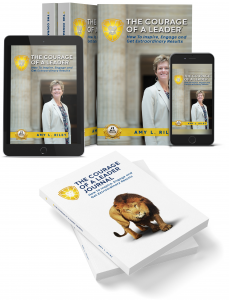Pillar 3: The Courage to Trust the Legacy
THE COURAGE OF A LEADER® 4 PILLARS
Our world, right now, needs leaders who know how to inspire, engage and get extraordinary results. As a leader, you’ve got opportunities, pressures, questions and complexities coming at you from all directions. You have team members who want meaningful work to do. You have stakeholders who need you to consistently create value. You work in dynamic marketplaces with competitive pressure. You have peers with whom you share the company’s resources. How do you effectively lead in these circumstances with courage?
In my 2-plus decades of experience developing leaders at all levels, I’ve seen that leaders who thrive in these circumstances consistently demonstrate courage in 4 distinct ways, which are captured in The Courage of a Leader 4 Pillars®:
- They uncover and share their authentic selves.
- They say what needs to be said.
- They trust the legacy (their leadership legacy).
- They are bold and create the extraordinary.
In this blog, I will share more about Pillar 3: The Courage to Trust the Legacy (your leadership legacy).
Leaders need the commitment, the ideas, the passion and the work of others to make big ideas come to life.
How do you get that kind of commitment from others? How do you get others fully engaged?
Well, you certainly need to craft clear, compelling communication. Yet, your ability to get people to follow you to new and interesting places is more directly related to your willingness to be vulnerable. Being vulnerable means saying what you don’t know, saying where you need help, keeping it real, being transparent, and allowing others to contribute and even change your mind. A leader who is willing to act and speak in these ways is a leader others can trust. And people need to trust you if they are going to take a risk with you and create something new.
I recently facilitated a program for new team leaders and one leader, very animatedly and passionately, pointed out how the senior leaders didn’t answer the direct questions being asked of them in the most recent All Employee meeting. “They are like politicians,” she said. “Repeating the same messages and not giving a true answer.” Others in the group agreed. It was disheartening! I’ve seen this organization’s C-level leaders speak candidly and vulnerably. Yet, that’s all it takes: one meeting where questions seem to be dodged, and some degree of trust is lost.
These comments reminded me of a Senior Leader, Anna, (from the same organization) who did an amazing job of answering questions and giving direction, when not all the answers were known. Her sales group was changing their business model. The change was going to impact nearly everything: roles, processes, perspectives, structure and objectives. Anna stated it would be a process of learning, growing and figuring out together. She said she was going to lay out what was known, what was set in stone, what was up for debate, and what needed everyone’s good ideas and risk-taking so they could find the best ways forward.
And then Anna proceeded to do just that. Her team was riveted. You could feel and hear the fear and anxiety in the room. These emotions were evident in the questions they asked. Yet, you could also sense the excitement. The energy rose when Anna replied with, “This is what you’ll need to study and determine. I don’t know how we’ll move this piece forward. I do know we’ve got the competence in this room to figure it out and create what our competitors haven’t.” Everyone was engaged in making the change happen. It wasn’t easy. There were uncomfortable debates. And their Senior Leader kept normalizing their experience. “This is what cutting-edge change looks like. It isn’t easy.”
70% of engagement is attributed to the leader, according to Gallup (Randall Beck and Jim Harter, Gallup Business Journal, April 21, 2015). You have a big influence on whether people’s heads and hearts are engaged. The big idea, the objectives for the initiative and the path forward need to make sense in people’s heads. Most leaders, with some work, can accomplish this. It’s employees’ hearts that usually aren’t engaged.
Release chemicals in their brains, if you want team members to truly care.
There are 2 chemicals that are released in the brain that have us feel valued, give us a sense of belonging and inspire us to want to work for the good of the team/project. The first, serotonin, is released in our system when we feel proud, the approval of others, supported and/or respected. When we feel lifted up by our leaders, we feel a sense of responsibility to offer something in return. As a leader, the more you give of yourself to help others succeed, the greater your value to the group and the more respect, dedication and passion they’ll have.
It’s not hard to get serotonin flowing, it just takes intentionality and commitment. Say, “Thank you,” share in a team meeting how each person contributed to the team’s recent success, ask questions to help an overwhelmed colleague prioritize her work, give him the chance to present his work in front of a larger audience. The examples of how you can release serotonin in others through your leadership are endless. That’s why serotonin is often referred to as the leadership chemical. And, it feels good to everyone involved. It’s a win/win.
The second related chemical is oxytocin. It’s often called the love chemical. Oxytocin creates the feeling we have when we are with close friends and loved ones. It helps us be generous, want to do things for others and stay connected. It helps team members feel camaraderie and safety with one another. The more a leader does to create an environment of openness and connection, the more oxytocin flows. As a leader, you can ask how employees are feeling; really listen carefully to their responses; show empathy; share how you’re feeling; get to know people and their interests, concerns, struggles and passions.
Both serotonin and oxytocin are long-lasting chemicals, get built up over time and feel great (unlike some other chemicals that are released in the brain). Leaders can create moments, processes and structures that allow serotonin and oxytocin to be released. They can create a culture of giving and receiving. Give praise, trust, approval and open forums and you’ll get loyalty and full engagement.
What courageous action will you take today?
How will you vulnerably connect with your colleagues?
How will you intentionally release some serotonin or oxytocin?














 A Summary of The Courage of a Leader® 4 Pillars
A Summary of The Courage of a Leader® 4 Pillars




